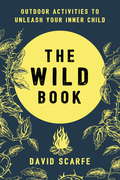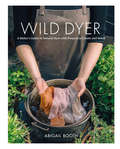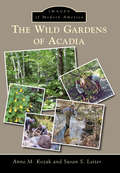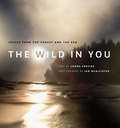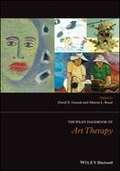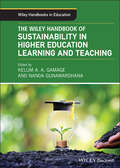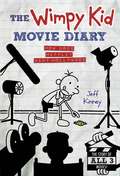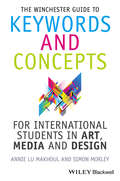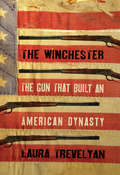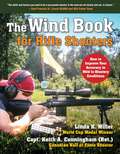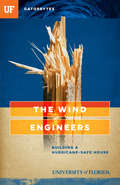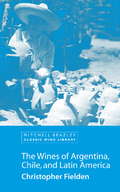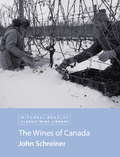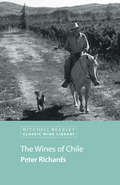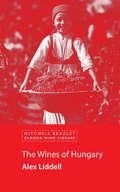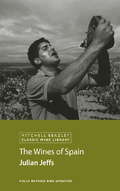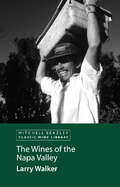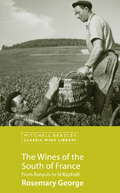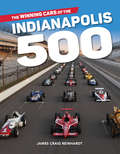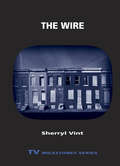- Table View
- List View
The Wild Book: Outdoor Activities to Unleash Your Inner Child
by David ScarfeIn a world in which we're never far from our phones or tablets, computers or consoles, we can often be blind to the joy that can be found in the great outdoors. We're building worlds in Minecraft when we could be building a raft; we're watching the latest Netflix show when we could be gazing at the stars; we're idly scrolling on social media when we could be strolling through woodlands; we're internet shopping when we could be panning for gold.Our phones may be smarter, but our experiences have shrunk down to the size of the screens in front of our eyes. The Wild Book is here to re-acquaint us with the wonders that await in the outside world. Beautifully produced, full of fun, easy-to-do games and activities - including how to make sloe gin, climb trees, build a fire, identify different cloud formations and make a shelter - this is the ultimate book to unleash your inner child.
The Wild Dyer: A Guide To Natural Dyes And The Art Of Patchwork And Stitch
by Abigail Booth`By teaching you the foundations of natural dyeing, and guiding you through the simple stitch techniques, this book will allow you to dip in and out of projects while learning how to forage for and grow your own dye plants.' In The Wild Dyer, Abigail Booth demystifies the `magic' of natural dyeing and shows how to use the results to stunning effect in 15 exquisite patchwork and stitch projects, including a drawstring forager's bag, an apron, samplers, cushions and a reversible patchwork blanket. Focusing on how to grow or gather your own dyeing materials - from onion and avocado skins to chamomile and comfrey, nettles and acorns - as well as scouring, mordanting (using fixative) and setting up a dye vat, Abigail explains how to create effective dyes. And once you have them, how you can produce beautiful, contemporary textiles that can then be used to create projects that build on your skills.
The Wild Dyer: A Maker's Guide to Natural Dyes with Beautiful Projects to create and stitch
by Abigail BoothFabrics colored with natural dyes have a beauty and subtlety all of their own. Onion and avocado skins, chamomile and birch bark, and nettles and acorns can produce lovely, ethereal colors and effects. The Wild Dyer demystifies this ecoconscious art, focusing on foraging and growing dying materials; repurposing kitchen trimmings; making and using long-lasting dyes; and creating stitched projects. Workspace setup, equipment, and fabric choices and care are all discussed. Beautiful photographs and easy-to-follow instructions illustrate how to make fifteen exquisite household items, from a drawstring bag to a gardener's smock and a reversible patchwork blanket. The Wild Dyer is a complete guide for both beginners and experienced artists seeking to expand their knowledge of this increasingly popular craft.
The Wild Dyer: A guide to natural dyes & the art of patchwork & stitch
by Abigail Booth`By teaching you the foundations of natural dyeing, and guiding you through the simple stitch techniques, this book will allow you to dip in and out of projects while learning how to forage for and grow your own dye plants.' In The Wild Dyer, Abigail Booth demystifies the `magic' of natural dyeing and shows how to use the results to stunning effect in 15 exquisite patchwork and stitch projects, including a drawstring forager's bag, an apron, samplers, cushions and a reversible patchwork blanket. Focusing on how to grow or gather your own dyeing materials - from onion and avocado skins to chamomile and comfrey, nettles and acorns - as well as scouring, mordanting (using fixative) and setting up a dye vat, Abigail explains how to create effective dyes. And once you have them, how you can produce beautiful, contemporary textiles that can then be used to create projects that build on your skills.
The Wild Gardens of Acadia (Images of Modern America)
by Anne M. Kozak Susan S. LeiterFounded in 1961 at Sieur de Monts Spring in Maine's Acadia National Park, the Wild Gardens of Acadia display, preserve, propagate, and label native plants in areas simulating natural plant communities. The gardens, which originated from a competition in growing native plants sponsored by the Bar Harbor Garden Club, continue to be developed and maintained by volunteers in partnership with Friends of Acadia and Acadia National Park. Each of the gardens' 13 habitats, ranging from mountain to beach to bog to deciduous and coniferous woods, displays plants native to the park. Since the founding, countless park visitors have come to the gardens to identify plants they have seen on walks or hikes or to learn more about cultivating native plants. Many of the images in this book are drawn from the extensive photograph collection of the Wild Gardens of Acadia.
The Wild Side of Photography
by Cyrill HarnischmacherGeared toward the adventurous photographer, The Wild Side of Photography provides a rich source of ideas and inspiration for fun projects ranging from clever to unconventional. Learn to build a shift/tilt lens for your DSLR from an old junkyard 120 film camera, try the camera toss, shoot images from a kite, use a peephole door viewer as a fisheye lens, or build your own pinhole camera. Get ready to capture the perfect aerial shot on your next commercial flight, and to paint beautiful night scenes using a flashlight as a lightbrush. Author/designer, Cyrill Harnischmacher, brought together 20 international authors and their unique projects to produce this intriguing book. Each project is presented with easy to understand instructional text, background info about the author and the project, and beautiful color images to illustrate what can be accomplished and how you can do it too. Topics include: - Laptop ministudio - Camera hacks - Pole monopods for aerial photography - Blur (motion blur, camera motion, out-of-focus) - Low budget astrophotography - Kite photography - Using the scanner as a camera - LittlePlanet views - Texture blending - Camera and lens building projects
The Wild in You
by Lorna Crozier Ian McallisterA testament to the miraculous beings that share our planet and the places that they live, The Wild in You is a deeply-felt creative collaboration between one of our time's best nature photographers and a very talented and creative poet. Inspired by the majestic and savage beauty of Ian McAllister's photographs, Lorna Crozier translates the wild emotion of these images into the language of the human heart: poetry. Featuring over 30 beautiful full-size photographs of wolves, bears, sea lions, jellyfish, and other wild creatures paired with 30 original poems, The Wild in You challenges the reader to a deeper understanding of the connection between humans, animals, and our shared earth.
The Wiley Handbook of Art Therapy
by David Gussak Marcia RosalThe most comprehensive art therapy book in the field, exploring a wide range of themes, A unique collection of the current and innovative clinical, theoretical and research approaches in the field, Cutting-edge in its content, the handbook includes the very latest trends in the subject, and in-depth accounts of the advances in the art therapy arena.
The Wiley Handbook of Sustainability in Higher Education Learning and Teaching (Wiley Handbooks in Education)
by Kelum A. A. Gamage Nanda GunawardhanaA comprehensive resource for higher education professionals interested in sustainability pedagogy In The Wiley Handbook of Sustainability in Higher Education Learning and Teaching, a team of distinguished researchers delivers an insightful reference for higher education professionals seeking to embed sustainability in learning and teaching. The book offers a way for higher education institutions to implement sustainability goals in their curricula and provides comprehensive guidance to educators, researchers and practitioners. The authors discuss recent developments in technological innovations, best practices, lessons learned, current challenges, and reflections in the area of sustainability teaching in higher education. They also examine the impact of the COVID-19 pandemic on sustainability education. With contributors from a variety of disciplines, including engineering, medicine, urban design, business, environmental science, and social science, the book considers the embedding of sustainability in regenerative learning ecologies, living laboratories, and transgressive forms of learning. It also includes: A thorough introduction to activist learning for sustainability and outcome-based education towards achieving sustainable goals in higher education Comprehensive explorations of factors that hinder the implementation of sustainability initiatives in higher education institutions Practical discussions of developing stakeholder agency in higher education sustainability initiatives In-depth examinations of global trends and country-specific initiatives in sustainability teaching Perfect for education developers seeking to incorporate sustainability, The Wiley Handbook of Sustainability in Higher Education Learning and Teaching is also ideal for academics, researchers, policymakers, and accreditation personnel working in the area of sustainability.
The Wimpy Kid Movie Diary (Dog Days Revised and Expanded Edition)
by Jeff KinneyIf you’ve ever wondered how a movie gets made, you’re not alone. Author and illustrator Jeff Kinney didn’t know either, but when his bestselling Diary of a Wimpy Kid series was turned into a live-action movie by 20th Century Fox, he learned how books get adapted for the screen in not one but three major motion pictures. Complete with photographs, script pages, storyboard sketches, costume designs, and original art by Jeff Kinney, The Wimpy Kid Movie Diary—now updated to include the new movie Diary of a Wimpy: Dog Days—is the perfect companion to the bestselling series.
The Winchester Guide to Keywords and Concepts for International Students in Art, Media and Design
by Annie Makhoul Simon MorleyThis welcome new resource for international students in art, design, and media provides clear explanations of the terminology they must master in order to fulfill their academic potential and enrich their professional careers. Offers a much-requested new resource that fills a gap in the academic market Tailored specifically to the needs of international students in art, design, and media Color-coded key words and phrases for quick reference Includes sections on study skills, academic expectations in Western institutions, methodologies, and important theorists An ideal handbook for curators and gallery staff everywhere for whom English is a non-native language
The Winchester: The Gun That Built an American Dynasty
by Laura Trevelyan&“Details the extraordinary life of Oliver Winchester, the company, and its rapid rise and slow fall as told by a distant family descendant.&”—American Gunsmith Arguably the world&’s most famous firearm, the Winchester Repeating Rifle was sought after by a cast of characters ranging from the settlers of the American West to the Ottoman Empire&’s Army. Laura Trevelyan, a descendant of the Winchester family, offers an engrossing personal history of the colorful New England clan responsible for the creation and manufacture of the &“Gun that Won the West.&” Trevelyan chronicles the rise and fortunes of a great American arms dynasty, from Oliver Winchester&’s involvement with the Volcanic Arms Company in 1855 through the turbulent decades of the nineteenth and twentieth centuries. She explores the evolution of an iconic, paradigm-changing weapon that has become a part of American culture; a longtime favorite of collectors and gun enthusiasts that has been celebrated in fiction, glorified in Hollywood, and applauded in endorsements from the likes of Annie Oakley, Theodore Roosevelt, Ernest Hemingway, and Native American tribesmen who called it &“the spirit gun.&” &“[A] detailed but accessible look at the life, times and commerce of Oliver Winchester—Trevelyan&’s great great great grandfather—and his many descendants of both the human and firearms varieties . . . Whether you&’re a fan of firearms or simply of American history, there is much to enjoy and learn in this easy-to-read and well-footnoted volume.&”—American Shooting Journal &“The book is beautifully illustrated, with fascinating photos of the Winchester family, and with well-known historical figures—including the Native American leader Geronimo and President Theodore Roosevelt—clutching their repeating rifles.&”—Times Literary Supplement
The Wind Book for Rifle Shooters: How to Improve Your Accuracy in Mild to Blustery Conditions
by Linda K. Miller Keith A. CunninghamAll other factors being equal, it is your ability to read the wind that will make the most difference in your shooting accuracy. The better you understand the behavior of the wind, the better you will understand the behavior of your bullet. Now, champion shooters Linda K. Miller and Keith A. Cunningham reveal everything they wish they&’d known about reading the wind before they started shooting (instead of having to learn as they went along) in concise, easy-to-read terms and accompanied with handy ninety-five diagrams. The Wind Book for Rifle Shooters contains straightforward guidance on the simple thought process they use to read the wind, the techniques and tactics they use to win matches, and the underlying skills that support both. Let these champions show you how to put together a simple wind-reading toolbox for calculating wind speed, direction, deflection, and drift. Then learn how to use these tools to read flags and mirage, record and interpret your observations, and time your shots to compensate for wind. Other topics covered include: Analyzing shot placementRecording and record keepingConfidence and following your hunchesAnd much more!The essential wind-reading basics taught in this book will absolutely improve your shooting skills, whether you're a target shooter, a plinker, a hunter or a shooting professional.
The Wind Engineers: Building a Hurricane-Safe House
by Jeff Klinkenberg University of FloridaThe University of Florida has an ambitious goal: to harness the power of its faculty, staff, students, and alumni to solve some of society's most pressing problems and to become a resource for the state of Florida, the nation, and the world. Hurricanes and tornadoes--and the devastation they leave in their wake--are feared across the globe, but at the University of Florida these natural phenomena are a fascinating research opportunity. At UF's Engineering School of Sustainable Infrastructure and Environment, wind engineers like Forrest Masters and David Prevatt study storm systems and design buildings to better withstand the forces of nature. Follow their stories as they venture inside Hurricane Wilma with wind gauges, travel to Joplin, Missouri to assess the wind-damage from the most powerful tornado in more than a half century, and conduct experiments with the lab's infamous "Multi-Axis Wind Load Simulator," ominously nicknamed "The Judge." Yet the job of the UF wind engineers does not end there. They take their findings to the drafting table, build roofs and walls, and test shingles, shutters, and garage doors. Their goal: to make sure our houses are still standing, and we are safe, after the storm. The stories chronicled in GATORBYTES span all colleges and units across the UF campus. They detail the far-reaching impact of UF's research, technologies, and innovations--and the UF faculty members dedicated to them. Gatorbytes describe how UF is continuing to build on its strengths and extend the reach of its efforts so that it can help even more people in even more places.
The Wines of Argentina, Chile and Latin America
by Christopher FieldenAfter Europe, Latin America is one of the major wine producing areas of the world, yet very little has been written about its wines. This title follows the transformation of winemaking in these countries, examines in detail each of the wine-growing areas, and explains how these now extremely popular wines were, until relatively recently, more or less unknown. There are details of more than 230 producers, from Peru to Cuba, with insight into the challenges faced by some of the lesser known countries and regions. It also explains the role of other internationally respected wine names such as Torres, Mondavi and Rolland.
The Wines of Argentina, Chile and Latin America
by Christopher FieldenAfter Europe, Latin America is one of the major wine producing areas of the world, yet very little has been written about its wines. This title follows the transformation of winemaking in these countries, examines in detail each of the wine-growing areas, and explains how these now extremely popular wines were, until relatively recently, more or less unknown. There are details of more than 230 producers, from Peru to Cuba, with insight into the challenges faced by some of the lesser known countries and regions. It also explains the role of other internationally respected wine names such as Torres, Mondavi and Rolland.
The Wines of Canada
by John SchreinerWritten by an award-winning writer, this is a reference to Canada's wine-producing regions, the grape varieties, producers, and their wines. The core of the book includes comprehensive details of the estates, as well as information about exciting projects and a discussion on developments in Canada's wine industry. The book also covers the range of internationally recognized Icewines.
The Wines of Chile
by Peter RichardsRegion by region, award-winning writer, Peter Richards takes us through all of Chile's many winemaking areas. Starting with the history of Chile and its wine industry, the work includes details on the country's diversity of terroirs, the range of wine styles available, and the variety of winemaking techniques in use, plus a topical discussion of recent developments. Full details of all the leading producers and their top wines form the core of this book.
The Wines of Hungary
by Alex LiddellThis reference to the 22 wine regions of Hungary shows how this country, with its once-proud wine tradition, reinvented itself after 45 years of communism, during which time the entire structure of grape growing and wine production was changed out of recognition. The author details how Hungary's re-adjustment, which still continues, has progressed through privatization, foreign investment and the dedication of small producers struggling to achieve quality standards in the face of a chronic lack of capital. He covers over 300 wine producers, not only from the famous regions like Tokaj and Villany, where significant progress has been made, but also from the lesser-known and as yet underdeveloped regions that suggest the potential to make world-class wines. There are detailed profiles of the leading producers, with assessments of their wines, plus maps detailing the key wine areas.
The Wines of Spain
by Julian JeffsThe transformation of the Spanish wine industry over the last 20 years has been astonishing. From a state of very considerable decay it has re-invented itself with great vigour and style. Four decades ago such reputation as the wines of Spain had rested on the declining quality of Sherry and the occasional majestic Rioja towering above the surrounding sea of mediocre, oxidised table wines. "How things have changed!" exclaims Julian Jeffs in the introduction to his valuable The Wines of Spain, the latest addition to Faber and Faber's series of wine books. Over the course of two years Jeffs put in a great deal of intensive research in Spain, travelling the length and breadth of the country, visiting growers and tasting their wines. The effort has paid off in a wealth of engrossing detail.The volume is organised into sections dealing with the main provinces or geographical regions--Aragon, Catalunya, Andalucia and so on--then within those by the individual Denominacion de Origen (DO). Within each DO the leading or most interesting bodegas are profiled, allowing Jeffs to build up a cumulative portrait of the regional characters. Especially evocative are the portions of the book dealing with the ancient and distinguished Sherry houses in Andalucia, many of them of course founded in the 18th or 19th centuries by British or Irish merchants. The account of the great Bodegas Vega Sicilia in Castilla is emblematic of the progress of the entire Spanish wine industry: Producing some of the world's finest wine up to the 1920s, it fell into poor practices and the quality and reliability of the wine suffered badly. Under the modernising current owners the wine has regained its former reputation. According to Julian Jeffs, Vega Sicilia "is on a Wagnerian scale, with all that master's subtlety and complexity." --Robin Davidson --This text refers to an out of print or unavailable edition of this title.
The Wines of Spain
by Julian JeffsThe transformation of the Spanish wine industry over the last 20 years has been astonishing. From a state of very considerable decay it has re-invented itself with great vigour and style. Four decades ago such reputation as the wines of Spain had rested on the declining quality of Sherry and the occasional majestic Rioja towering above the surrounding sea of mediocre, oxidised table wines. "How things have changed!" exclaims Julian Jeffs in the introduction to his valuable The Wines of Spain, the latest addition to Faber and Faber's series of wine books. Over the course of two years Jeffs put in a great deal of intensive research in Spain, travelling the length and breadth of the country, visiting growers and tasting their wines. The effort has paid off in a wealth of engrossing detail.The volume is organised into sections dealing with the main provinces or geographical regions--Aragon, Catalunya, Andalucia and so on--then within those by the individual Denominacion de Origen (DO). Within each DO the leading or most interesting bodegas are profiled, allowing Jeffs to build up a cumulative portrait of the regional characters. Especially evocative are the portions of the book dealing with the ancient and distinguished Sherry houses in Andalucia, many of them of course founded in the 18th or 19th centuries by British or Irish merchants. The account of the great Bodegas Vega Sicilia in Castilla is emblematic of the progress of the entire Spanish wine industry: Producing some of the world's finest wine up to the 1920s, it fell into poor practices and the quality and reliability of the wine suffered badly. Under the modernising current owners the wine has regained its former reputation. According to Julian Jeffs, Vega Sicilia "is on a Wagnerian scale, with all that master's subtlety and complexity." --Robin Davidson --This text refers to an out of print or unavailable edition of this title.
The Wines of the Napa Valley
by Larry WalkerCalifornia-based wine expert Larry Walker offers indepth reference on the wines of one of the world's most prominent wine-producing regions, the Napa Valley. He explores the history of this region and gives a full description of the grape varieties, viticulture, and winemaking techiques, and recommends vintages to look out for. He also details the top producers and their wines, and includes a topical discussion on recent wine developments in this region.
The Wines of the South of France
by Rosemary GeorgeKnown traditionally for its dramatic landscapes, the South of France is becoming one of the most vibrant and exciting of French vineyard areas. Every key wine area is covered from Banyuls on the Spanish border to the island of Corsica. The key wine producers and their wines are featured, with details of the regions, laws and grape varieties. The author reveals the fascinating developments in the vineyards and the cellars throughout this region's many wine-producing locations and how new appellations are more regularly rewarded here than in any other wine region in France.
The Winning Cars of the Indianapolis 500
by James Craig ReinhardtAt speeds of over 230 miles per hour, the Indy open-wheel race cars set the bar for American Championship car racing. For over 100 years, the Indy cars and their drivers have drawn hundreds of thousands of spectators to Speedway, Indiana, with another 6 million people watching the race on television or by live stream. In The Winning Cars of the Indianapolis 500, James Craig Reinhardt, author and official tour guide for the Indianapolis Motor Speedway, details the history of the famous race and how the open-wheel race cars have evolved over the last century. Starting in 1911 with the first running of the Indy 500, Reinhardt profiles each race and car, including the starting position, engine, tires, race speed, margin of victory, and much more. Featuring nearly 200 images of the automobiles and individuals who make the race renowned, this book showcases the top drivers and how racing has changed through two world wars, the Great Depression, and unforgettable accidents. This beautifully illustrated book is a must-have for veteran and rookie race fans alike.
The Wire
by Sherryl VintFrequently described by creator David Simon as a novel for television, The Wire redefined the police serial format by unfolding its narrative across many episodes, constructing themes for each of its seasons, and refusing to portray individual crimes outside of their social context. While it never achieved spectacular ratings or won an Emmy during its 2002-2008 run on HBO, the show was honored with several awards and has been described by critics as the best show on television. In this volume, author Sherryl Vint takes a close look at several episodes of The Wire to argue that the series challenges our understanding of the relationship between entertainment and social critique. Informed by recent work on race, poverty, and the transformation of the American inner city through neoliberalism, Vint provides a compelling analysis of The Wire in four chapters. First, she examines the season 1 episode "The Buys" as an example of the ways in which The Wire diverges from the police procedural format. She continues by considering season 2's "All's Prologue" and season 3's "Middle Ground" to explore in more detail The Wire's critique of the exclusions of the capitalist economy. In the final two chapters, she looks at "Final Grades," the fourth season finale, to highlight the problems with institutional inertia and show both the need for and barriers to reform, and uses the season 5 episode "Clarifications" to consider the failure of the media to adequately reflect the social issues depicted in The Wire. One of the landmark series of recent television history, The Wire is ripe for research and discussion. Fans of the series and those interested in social commentary and the media will appreciate Vint's new analysis in this volume.
